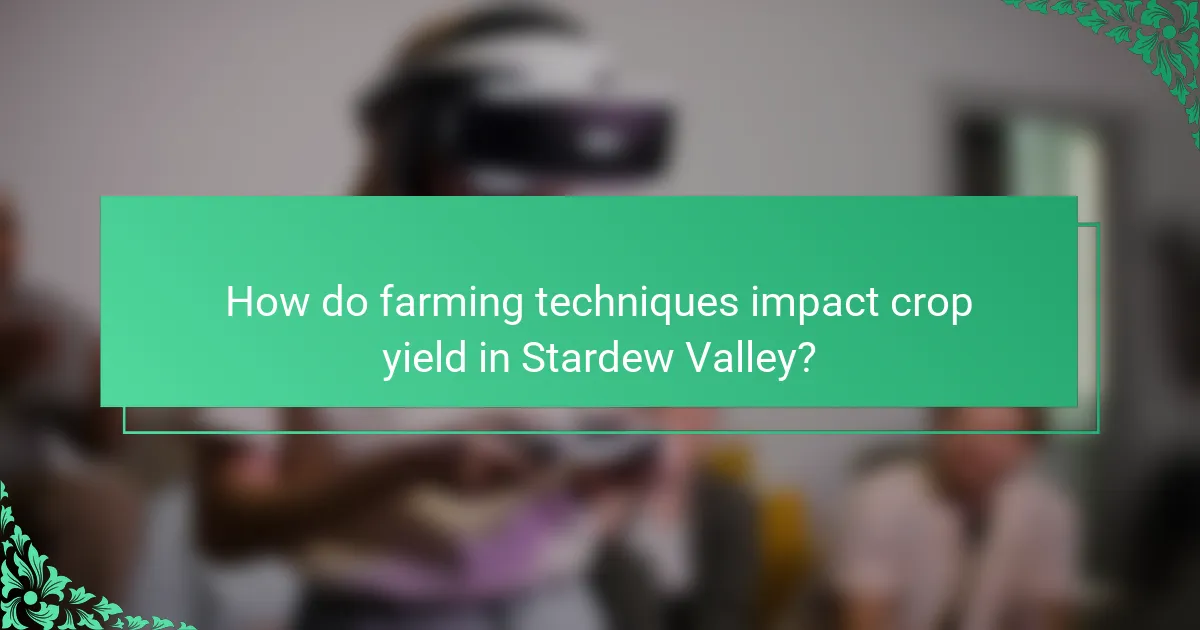Mastering farming techniques in Stardew Valley can significantly boost your crop yields. Explore effective methods like crop rotation and soil management, discover essential crafting guides for tools and structures, and engage in community events that enhance social interaction and provide unique rewards. Optimize your strategies for resource management and crop selection to maximize productivity and enjoyment in the game.

How do farming techniques impact crop yield in Stardew Valley?
Farming techniques significantly impact crop yield in Stardew Valley. Effective methods include crop rotation, soil quality management, and the use of fertilizers.
Crop rotation enhances soil nutrients, leading to higher yields. For example, planting different crops each season prevents soil depletion. Soil quality, influenced by tilling and the addition of organic matter, directly affects growth rates. Fertilizers provide essential nutrients, boosting crop performance.
Utilizing sprinklers automates watering, saving time and ensuring consistent hydration. This practice leads to healthier crops, which can yield more produce. Additionally, selecting high-quality seeds can result in superior harvests, enhancing overall productivity.
What are the most effective crop rotation strategies?
Crop rotation strategies in Stardew Valley enhance soil fertility and optimize crop yields. Effective methods include alternating between crops with different nutrient needs, such as planting potatoes followed by wheat. This rotation helps prevent soil depletion and reduces pest issues. Incorporating cover crops like clover can improve soil health and provide additional benefits. Additionally, timing rotations with seasonal changes maximizes growth potential and aligns with community events for harvesting.
Which fertilizers enhance growth rates for different crops?
Fertilizers that enhance growth rates for different crops in Stardew Valley include Speed-Gro, which reduces crop growth time by 10%, and Deluxe Speed-Gro, reducing it by 25%. Other effective options are the Quality Fertilizer, which increases the chance of higher quality crops, and the Basic Fertilizer, which boosts crop growth speed but to a lesser extent. Each fertilizer has specific uses depending on the crop type, so choosing the right one is essential for maximizing yield.
How does seasonal planting affect harvest quality?
Seasonal planting significantly enhances harvest quality by aligning crop growth with optimal weather conditions. This technique maximizes yield and nutrient content, resulting in healthier produce. For instance, spring planting often yields vibrant, nutrient-rich vegetables due to favorable temperatures and moisture levels. In contrast, crops planted out of season may suffer from reduced growth and lower quality. Therefore, understanding seasonal cycles is crucial for successful farming in Stardew Valley.
What tools are essential for maximizing farming efficiency?
Essential tools for maximizing farming efficiency in Stardew Valley include the hoe, watering can, scythe, and axe. These tools enhance crop management, resource gathering, and land preparation. Upgrading tools improves their effectiveness, allowing for quicker farming tasks. Additionally, crafting machines like the preserve jar and keg can increase profitability by processing crops into valuable products.

What crafting guides are essential for beginners in Stardew Valley?
Essential crafting guides for beginners in Stardew Valley include recipes for basic tools, crafting stations, and essential items. Familiarizing yourself with the crafting menu helps in understanding resource management. Key guides focus on crafting a furnace, preserve jar, and bee house, which enhance productivity. Additionally, learning to craft basic farm structures like scarecrows and sprinklers is crucial for efficient farming.
Which crafting recipes should players prioritize early on?
Players should prioritize crafting basic tools, sprinklers, and storage early on. These recipes enhance efficiency and resource management.
1. Crafting a Stone Axe allows for quicker wood gathering.
2. A Copper Pickaxe improves mining speed and resource collection.
3. Sprinklers automate watering crops, saving time daily.
4. Chests provide essential storage for organizing items.
5. A Furnace is crucial for smelting ores and crafting bars.
6. The Scarecrow protects crops from crows, ensuring harvests are secure.
How do crafted items contribute to farming and community goals?
Crafted items significantly enhance farming and community goals in Stardew Valley. They provide essential resources, boost farm productivity, and contribute to community bundles.
Crafted items, such as fertilizers and artisan goods, improve crop yield and quality. For example, using quality fertilizers increases the chance of growing high-quality crops, which can be sold for higher profits. Artisan goods like cheese and wine not only sell for more than raw products but also fulfill community bundle requirements.
Additionally, crafted items foster community engagement. Completing bundles with crafted goods unlocks rewards that benefit the entire village, such as new buildings and facilities. This collaborative effort strengthens community bonds and enhances the overall gameplay experience.
Overall, crafted items serve as a vital link between farming success and community development in Stardew Valley, driving players to engage in both activities for mutual benefits.
What are the best upgrades for crafting stations?
The best upgrades for crafting stations in Stardew Valley enhance efficiency and broaden crafting options. Key upgrades include the Kitchen for cooking, the Furnace for smelting ores, and the Crafting Bench for advanced recipes. Each upgrade significantly boosts productivity and resource management.

How do community events influence player engagement in Stardew Valley?
Community events significantly enhance player engagement in Stardew Valley by fostering social interaction and collaboration. These events create opportunities for players to connect, share strategies, and celebrate achievements together. For example, seasonal festivals encourage participation in mini-games and contests, which can lead to unique rewards. Engaging in these events strengthens community bonds, making the gameplay experience more immersive and enjoyable. As a result, players are more likely to return and invest time in the game, driven by the sense of belonging and shared experiences.
What are the key annual festivals and their benefits?
Stardew Valley features several key annual festivals that enhance community engagement and provide various benefits. These festivals include the Egg Festival, Flower Dance, and Harvest Festival, each offering unique activities and rewards.
The Egg Festival occurs in spring, promoting social interaction through egg hunts. Players can earn prizes like the Straw Hat. The Flower Dance in spring encourages relationships, allowing players to dance with villagers, improving friendship levels. The Harvest Festival in fall focuses on sharing food and participating in contests, rewarding players with valuable items and community spirit.
These festivals foster a sense of belonging and enhance gameplay through rewards, community building, and seasonal activities.
How can players prepare for seasonal community challenges?
Players can prepare for seasonal community challenges by gathering resources, planning crops, and participating in community events. Focus on collecting items that are frequently required for these challenges, such as seasonal crops and artisan goods.
Timing is crucial; ensure crops are planted early enough to mature before the challenge deadline. Collaborate with other players to share tips and strategies, enhancing your chances of success.
Regularly check the bulletin board for updates on upcoming challenges to stay informed and ready. Engaging in these activities not only boosts your farm’s productivity but also strengthens community bonds.
Which events offer unique rewards that enhance gameplay?
Events in Stardew Valley that offer unique rewards include the Festival of Ice, the Egg Festival, and the Night Market. These events enhance gameplay by providing exclusive items and experiences.
1. Festival of Ice: Players can win the Ice Poppy, a seasonal flower, and participate in ice fishing competitions.
2. Egg Festival: This event features an egg hunt where players can earn the Straw Hat and gather seasonal eggs.
3. Night Market: Offers rare items like the Mermaid’s Pendant and special foods, enhancing player interaction and exploration.
These unique rewards contribute to the overall farming and crafting experience in the game.

What are the unique attributes of rare crops in Stardew Valley?
Unique attributes of rare crops in Stardew Valley include their high market value, specific growing conditions, and limited availability. These crops, such as Ancient Fruit and Dragon Fruit, often require unique seeds or special events for cultivation. They provide significant benefits, including increased energy restoration and crafting ingredients for artisanal goods. Rare crops can also contribute to community bundles, enhancing the player’s overall experience and progression in the game.
How do ancient fruit and starfruit differ from standard crops?
Ancient fruit and starfruit differ from standard crops in growth time, yield, and value. Ancient fruit takes 28 days to mature and produces multiple harvests, while starfruit matures in 13 days, yielding a single harvest. Ancient fruit sells for 550 gold per unit, compared to starfruit’s 750 gold. Additionally, ancient fruit can be used to craft wine, enhancing its value further.
What special conditions are needed to grow these rare crops?
Rare crops in Stardew Valley require specific conditions to thrive. These include unique soil types, specific seasons for planting, and particular care routines. For instance, ancient fruit needs to be grown in a greenhouse or during summer and fall, while fairy roses flourish in summer and are sensitive to watering schedules. Understanding these requirements ensures successful cultivation and maximizes yield.

How can players optimize their farming and crafting strategies?
Players can optimize their farming and crafting strategies by focusing on crop selection, resource management, and efficient crafting processes. Prioritize high-value crops like blueberries and strawberries for maximum profit. Utilize sprinklers to automate watering and save time. For crafting, gather essential resources like wood and stone early to create necessary tools and machines. Participate in community events for unique rewards that enhance farming efficiency.
What common mistakes should be avoided in farming?
To succeed in farming in Stardew Valley, avoid these common mistakes. Failing to plan crop rotations can lead to wasted resources and reduced yields. Ignoring seasonal crops limits profitability, while neglecting farm layout can hinder efficiency. Overlooking community events can prevent valuable rewards and relationships. Lastly, underestimating the importance of crafting tools and items can slow down progress.
Which expert tips can enhance crafting efficiency?
To enhance crafting efficiency in Stardew Valley, prioritize resource management and planning. Focus on gathering essential materials and upgrading your crafting stations to unlock advanced recipes.
1. Organize inventory to streamline access to crafting materials.
2. Utilize the crafting menu frequently to familiarize yourself with recipes.
3. Experiment with different combinations to discover unique items.
4. Participate in community events for exclusive crafting recipes and materials.
How do players balance farming with community engagement?
Players balance farming with community engagement by prioritizing tasks and scheduling activities. Efficient time management allows players to maximize crop yields while participating in festivals and events. Engaging in community activities fosters relationships, unlocking unique rewards that enhance farming. Players often use seasonal planning to align farming cycles with community events, ensuring both aspects thrive simultaneously.


